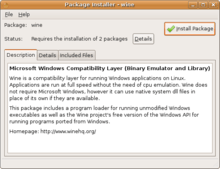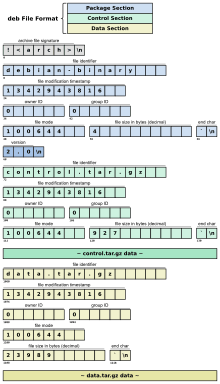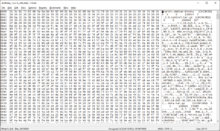deb (file format)
|
The GNOME icon for deb files | |
| Filename extension |
.deb, .udeb |
|---|---|
| Internet media type |
application/vnd.debian.binary-package[1] |
| Developed by | Debian |
| Type of format | Package management system |
| Container for | Software package |
| Extended from | ar archive, tarball |
| Website | deb format specification |
deb is the format, as well as extension of the software package format for the Debian distribution and its derivatives.
Design

Debian packages are standard Unix ar archives that include two tar archives. One archive holds the control information and another contains the installable data.[2]
dpkg provides the basic functionality for installing and manipulating Debian packages. Generally end users don't manage packages directly with dpkg but instead use the APT package management software or other APT front-ends such as aptitude (nCurses) and synaptic (GTK+).[3]
Debian packages can be converted into other package formats and vice versa using alien, and created from source code using checkinstall or the Debian Package Maker.[4]
Some core Debian packages are available as udebs ("micro debs"), and are typically used only for bootstrapping a Debian installation. Although these files use the udeb filename extension, they adhere to the same structure specification as ordinary deb files. However, unlike their deb counterparts, udeb packages contain only essential functional files.[5] In particular, documentation files are normally omitted. udeb packages are not installable on a standard Debian system, but are used in Debian-Installer.
Implementation


Prior to Debian 0.93 a package consisted of a file header and two concatenated gzip archives.[6] Since Debian 0.93, a deb package is implemented as an ar archive.[7] This archive contains three files in a specific order:[8][9]
- debian-binary - Contains a single line giving the package format version number. (
2.0for current versions of Debian).[9] - control archive - A tar archive named
control.tarcontains the maintainer scripts and the package meta-information (package name, version, dependencies and maintainer). Compressing the archive with gzip or xz is supported. The file extension changes to indicate the compression method.[9][2] - data archive - A tar archive named
data.tarcontains the actual installable files. Compressing the archive with gzip, bzip2, lzma or xz is supported. The file extension changes to indicate the compression method.[9][2]
Control archive
The control archive contents can include the following files:
- control contains a brief description of the package as well as other information such as its dependencies.[10][11][12][13]
- md5sums contains MD5 checksums of all files in the package in order to detect corrupt or incomplete files.[14]
- conffiles lists the files of the package that should be treated as configuration files. Configuration files are not overwritten during an update unless specified.[15]
- preinst, postinst, prerm and postrm are optional scripts that are executed before or after installing or removing the package.[15][16]
- config is an optional script that supports the debconf configuration mechanism.[17]
- shlibs list of shared library dependencies.[18][19]
Signed Packages
Debian-based distributions support GPG signature verification of signed Debian packages, but most (if not all) have this feature disabled by default.[20] Instead packages are verified by signing the repository metadata (i.e. Release files). The metadata files in turn include checksums for the repository files as a means to verify authenticity of the files.[21][22] Currently there are two different implementations for signing individual packages. The first is done via the debsigs / debsig-verify toolset, which is supported by dpkg.[20][23] The second is done through the dpkg-sig program which is not supported by dpkg, so the packages have to be manually checked with the dpkg-sig program.[20][24][25][26] Both formats add new section(s) to the ar archive to store the signature information, but the formats are not compatible with one another.[20] Neither of the modifications to the package format are listed in the official Debian handbook or man page about the binary package format.[27][8]
Adoption
- Debian packages are used in distributions based on Debian, such as Ubuntu and many others.
- Fink, a port of dpkg and APT to Mac OS X, uses deb packages.[28][29]
- Nexenta OS, a discontinued OS based on OpenSolaris, included Debian package management software and the use of deb packages.
- Debian GNU/kFreeBSD, a OS that uses a GNU based userland and the FreeBSD kernel.
- Debian GNU/Hurd.
- Cydia package manager used on jailbroken iOS devices (iPhones, iPads and iPods).[30][31]
See also
References
- ↑ "Media Type Registration for vnd.debian.binary-package". Internet Assigned Numbers Authority. Retrieved 21 May 2014.
- 1 2 3 Raphaël Hertzog (17 Sep 2010). "How to create Debian packages with alternative compression methods". raphaelhertzog.com. Retrieved 26 Aug 2016.
- ↑ "Debian Courses/Maintaining Packages/Packages Management". debian.org. 31 Oct 2010. Retrieved 26 Aug 2016.
- ↑ "Overview of Debian Maintainer Tools / Alien". debian.org. n.d. Retrieved 26 Aug 2016.
- ↑ "Chapter 3. D-I components or udebs". debian.org. n.d. Retrieved 26 Aug 2016.
- ↑ "deb-old(5) man page: Debian old binary package format". manpages.debian.org. Retrieved 2017-04-23.
- ↑ Lucas Nussbaum (16 Oct 2014). "Debian Packaging Tutorial" (PDF). debian.org. Retrieved 26 Aug 2016.
- 1 2 "deb(5) man page: Debian binary package format". manpages.debian.org. Retrieved 2017-04-23.
- 1 2 3 4 "Debian Binary Package Building HOWTO/3. Package Structure". tldp.org. n.d. Retrieved 26 Aug 2016.
- ↑ "deb-control(5) man page: Debian packages' master control file format". manpages.debian.org. Retrieved 2017-04-23.
- ↑ "Debian Policy Manual Chapter 5 - Control files and their fields". debian.org. 30 Mar 2016. Retrieved 26 Aug 2016.
- ↑ Josip Rodin and Osamu Aoki (9 Jun 2015). "Debian New Maintainers' Guide - Ch4 Required files under the debian directory". debian.org. Retrieved 26 Aug 2016.
- ↑ "Debian Policy Manual Ch7 - Declaring relationships between packages". debian.org. 30 Mar 2016. Retrieved 26 Aug 2016.
- ↑ "The Debian Administrator's Handbook - Package Meta-Information". debian-handbook.info. n.d. Retrieved 26 Aug 2016.
- 1 2 "Chapter 7 - Basics of the Debian package management system". debian.org. 1 May 2015. Retrieved 26 Aug 2016.
- ↑ "Debian Maintainer Scripts". debian.org. 11 Oct 2012. Retrieved 26 Aug 2016.
- ↑ Joey Hess (n.d.). "The Debconf Programmer's Tutorial - The Config Script". fifi.org. Retrieved 26 Aug 2016.
- ↑ "dpkg-shlibdeps(1) man page". manpages.debian.org. Retrieved 2017-04-23.
- ↑ "Debian Policy - 8.6 Dependencies between the library and other packages". debian.org. 30 Mar 2016. Retrieved 26 Aug 2016.
- 1 2 3 4 Joe Damato (28 Oct 2014). "HOWTO: GPG sign and verify deb packages and APT repositories". packagecloud.io. Retrieved 26 Aug 2016.
- ↑ "APT repository internals". packagecloud.io. 4 Aug 2015. Retrieved 26 Aug 2016.
- ↑ "SecureApt - All about secure apt". debian.org. 22 Sep 2015. Retrieved 26 Aug 2016.
- ↑ "debsig-verify(1) man page". manpages.debian.org. Retrieved 2017-04-23.
- ↑ "debsigs(1) man page". manpages.debian.org. Retrieved 2017-04-23.
- ↑ Andreas Barth (29 Dec 2003). "Integrating signatures into Debian archive files". turmzimmer.net. Archived from the original on 2006-02-22. Retrieved 29 Dec 2003.
- ↑ "policy for debsigs". turmzimmer.net. 1 Feb 2004. Archived from the original on 2006-07-14. Retrieved 1 Feb 2004.
- ↑ "The Debian Administrator's Handbook - Ch5. Packaging System: Tools and Fundamental Principles". debian.org. n.d. Retrieved 26 Aug 2016.
- ↑ "Fink FAQ - General Questions". finkproject.org. 6 Jun 2015. Retrieved 26 Aug 2016.
- ↑ "Fink FAQ - Installing, Using and Maintaining Fink". finkproject.org. 6 Jun 2015. Retrieved 26 Aug 2016.
- ↑ Jay Freeman (n.d.). "Bringing Debian APT to the iPhone". saurik.com. Retrieved 26 Aug 2016.
- ↑ Erica Sadun (28 Feb 2008). "Debian-style installation arrives on iPhone". engadget.com. Retrieved 26 Aug 2016.
External links
- Debian FAQ: Basics of the Debian package management system
- Debreate - Debian Package Creator GUI
- .deb feature support
- Manipulating debs directly with standard utilities
- Anatomy of a Debian package video

